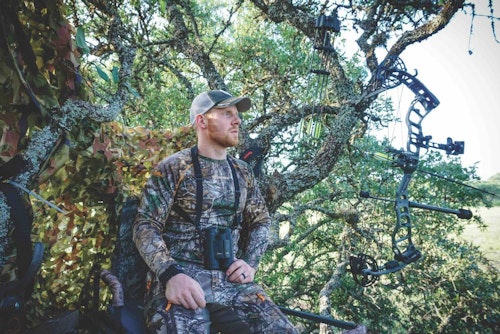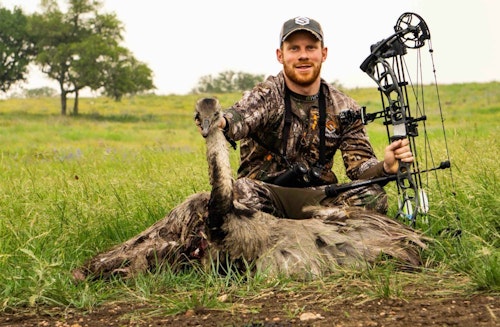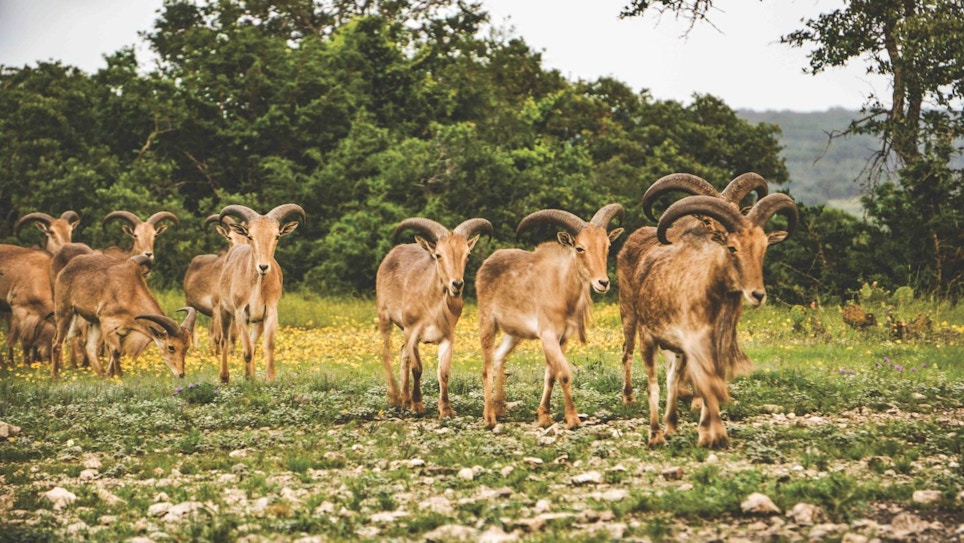My first evening in a Texas treestand stirred invigorating feelings. Hunting from an elevated position in May felt unusual; I’d previously chased only hogs and turkeys at eye-level during spring. The thought of numerous exotic game species frequenting the area also added new undercurrents. A beginner to hunting exotics, my hit list — rhea, feral hogs, aoudad, blackbuck and axis deer — was beyond intriguing. Plus, the landscape, at least to a Wisconsin boy, was quite exotic. I had to pinch myself; nope, I wasn’t fantasizing.
A month and a half earlier, friend Tim Kent invited me to bowhunt exotics with several others and himself at the Lazy CK Ranch in Mountain Home, Texas. The idea would be to connect with a few folks from FeraDyne Outdoors to test out their latest product offerings, then provide feedback afterwards. Initially, I was a bit skeptical that it would be a canned hunt because most exotic-hunting opportunities exist within high-fence confines. I hadn’t previously done anything like this. I thanked Kent for the invite and told him I’d think about it.
I explained the opportunity to my bride, and she said, “You’d be foolish not to go! The worst thing that could happen is you’ll bring home meat.” She had a point. Just to make sure it wouldn’t be a pen hunt (there’s a big difference), I browsed Lazy CK’s website and found that the ranch encompasses 7,000 acres of sprawling Hill Country. Nope, not a pen hunt. I RSVP’d to Kent, “I’m in!”
Texas Bound
After my red-eye flight to Chicago, I found Kent on my connecting flight to San Antonio. We landed in San Antonio later that morning. Once the others had arrived and grabbed their luggage, we boarded two separate vehicles operated by Lazy CK staff. On the way to the ranch, we obtained our $48 nonresident five-day special hunting licenses at Walmart, and then grabbed lunch, which included a discussion of bowhunting plans with our hosts.
We could bowhunt from pre-placed stands and blinds, or pursue exotics spot-and-stalk style. We also learned that a huge mountain lion had been spotted on the ranch just a month before our arrival. It hadn’t occurred to me previously that game from outside the high fence could get in. Now I knew: Hogs and predators can come and go without much issue.
Arriving at Camp
After a nearly two-hour drive from San Antonio to the Lazy CK Ranch, we saw the familiar face of Tom Miranda on the sign at the ranch gate. He hosts an annual bowhunting camp at the Lazy CK. Clients who book for that week get to share camp with Miranda.
After signing waivers and liability releases, we were shown to the beautiful main lodge and then our separate cabins. Each of us was met with unexpected luxury. After dropping off our luggage, we were paired with Lazy CK guides. My guide, Chris Miller, is as Texas as they come, his Lone Star charisma projecting through his voice and demeanor. “We’ll leave around 6 p.m.” Miller said after we shook hands.
After a power nap, I walked out my cabin door to the camp’s archery range. My Rocky Mountain Driver 3-Pin sight was unaffected by the flight, my arrows stacking in the kill zone at multiple ranges. With that, I dressed in my camo, laced up my boots and met Miller at the Kawasaki UTV we’d use to reach our hunting area.

The Adventure Begins
My first evening on stand produced a pod of rhea (birds that resemble emus). Interestingly, these birds were first introduced to the ranch to manage fire ants and stomp rattlesnakes. The ranch now teems with them, making a most unique hunting opportunity comparable to an African ostrich, I suppose. The sharp-eyed dominant male caught movement as I drew, and although I could’ve released a high-percentage shot as he slowly walked away, I passed. It was the first evening, and with a hammering headache, I didn’t want to risk poor judgment. I was covered up in whitetails all evening.
I hunted the same stand the following morning. Again, whitetails and more whitetails. A couple of young male rhea ambled through, but offered no shot. Next, a few axis does appeared in the distance. Fierce Texas winds soon drove me from the wavering tree, and when I stepped onto the ground, I was treated to three wildebeests in the distance.
First Blood
The second evening, Miller and I shared a blind where aoudad had been frequenting; it was sweltering. We checked the blind for snakes and then crawled in, the violent winds still engulfing the Texas landscape. Miller is exceptionally educated on all things Texas, so it was fun to pick his brain as we watched whitetails come and go. Eventually, two female oryx graced us with their presence, followed by a velvet-clad sika buck. I was on the edge of my seat the entire afternoon.
Suddenly, a lone aoudad ram caught my attention. Miller whispered that the ram was fairly young. “Let’s watch him and see if any others are behind him.” I nodded to let him know I understood.
A few minutes later, the ram turned broadside at 22 yards. “You can keep waiting, or you can take him. Your call,” Miller whispered.
“I’m going to draw back, put the pin on him and see how everything feels,” I said. At full draw, I leveled my bow, centered the scope in my peep and planted my 20-yard pin at mid-height and tight to the shoulder. Miller had begun recording with my digital camera, and without informing him, I increased tension on the trigger and stuck the ram right in the heart. His death run ended abruptly, the result of a well-placed Rage Hypodermic NC-tipped Carbon Express MAXIMA XRZ arrow.
Shortly after, an entire aoudad herd came in, the lead ram a monster. Once they left, we crept out of the blind, retrieved my ram and shot some quick photos in the waning daylight. It felt great to finally take my first exotic animal.

Axis and Blackbuck Encounters
The following morning, Miller and I hunted a blind where hogs and axis deer had been frequenting. We heard hogs grunt downwind and behind us. Obviously, they’d smelled us. Soon after, two young axis bucks appeared across the clearing. Once they left, so did we.
I learned that our group had taken its quota of axis deer, so my personal hit list now included only rhea, hogs and blackbuck. Before I even arrived in Texas, I had my heart set on a blackbuck, for they truly exemplify the term “exotic.”
The third afternoon, a mature broken-horned blackbuck appeared, but kept his distance all evening. All I could do is watch from my treestand. A young buck and two does offered lots of shooting opportunities, which I passed. Again, whitetails came and went nonstop.
The Haunted Blind
I’d heard rumors in camp of a blind decorated with hundreds of daddy long-legs spiders. Miller hadn’t told me we’d be hunting there the next morning. He dropped me off at the blind, then retreated several hundred yards to observe the morning’s events.
Carefully, I used my phone’s flashlight to get organized inside the blind. In the light, I noticed the Halloween theme. Spiders everywhere! It was morbid, but I’m not squeamish, so I paid them little to no mind.
Some sika and whitetail does visited the clearing, but they smelled me and spooked. That’s when a stout male rhea — distinguishable by the plumage and black band at the base of his neck — surprised me.
When the bird was positioned well, I drew. I took great care to line everything up as I do while practicing, then slowly increased back tension to execute the shot. The arrow nailed the quartering bird perfectly, exiting just below the base of his neck on the opposite side. He stumbled in a couple circles, then slumped in a heap. Another perfect hit. I was stoked!
Blackbuck or Bust
At midday back at the lodge, I nudged a drowsy Miller and suggested, “Let’s go stalk a blackbuck. Time’s running out.” He said, “Let’s do it!” I changed into camo and met him at the Kawasaki.
We drove only a short distance when he spotted the broken-horned blackbuck from the evening prior. He was several hundred yards away and bedded within what appeared to be bow range of a head-high berm. The wind direction was ideal. Off I went, Miller trailing behind.
Twenty minutes later, I ranged the buck at 63 yards from the berm I now utilized as cover. There’d be no getting closer. I’d either have to shoot or pass. I felt confident I could make the shot. I drew back four different times, but when I’d start settling my pin on the buck, the crosswind would jerk the pin erratically about. Finally, the wind died just long enough to steady my pin and execute a surprise release. The shot felt good, but my arrow whizzed past, just high. Game over.
Finishing Strong
I rejoined Miller, who’d watched the stalk from a distance. He believed we could locate another blackbuck if we stayed persistent, though neither of us realized it would happen so quickly. We were idling along when we simultaneously spotted a blackbuck buck and doe, feeding about 225 yards away and unaware of our presence due to the wind. Binocular glued to his eyes, “That’s a really good one,” Miller, whispered. I nodded. A few whitetail does and the blackbuck doe complicated matters, but we parked the UTV out of sight and then tiptoed toward the feeding buck.
Eventually, the whitetails spotted us and spooked, but the blackbuck and his doe, still 200 yards off, couldn’t pinpoint the danger, so they just started walking to our right. We watched them for a few moments, then suddenly Miller said, “They’re coming right at us!” I’d already given him my rangefinder, so I hooked up my release and drew back when the bounding blackbucks disappeared behind oak trees, still coming our way.
We both grunted to stop the male for a 15-yard chip shot, but he continued running. Finally, he stopped at the edge of a hill, and Miller said, “48 yards!” Quickly, I adjusted my sight, stepped backward and kneeled down. With a narrow window, I drew back, settled my pin low on the quartering buck and applied pressure to the trigger. I heard the Rage Trypan’s blades deploy, and even though the buck hit 50 or 60 miles per hour within seconds, we saw blood pumping out and knew my hit was lethal. High fives ensued.
We waited several minutes, and then searched for blood — 10 minutes had passed when Miller found the first crimson stain on the parched Texas soil. The blood trail led us a few hundred yards to the most gorgeous — and tasty, I might add — specimen I’ve ever harvested.
That satisfying spot-and-stalk hunt concluded my Texas adventure. After having experienced my first exotic hunt, I now understood what it was all about. I’d do it again in a heartbeat.

Sidebar: Texas Tackle
My Prime Logic compound proved perfect for all facets of my Texas exotic bowhunt. From tight ground blinds to brushed-in treestands, its 31-inch length maneuvered easily, and its stout 4.3-pound mass weight (bow only) anchored well in the Texas winds when paired with my Stokerized SL11 stabilizer.
I outfitted the Logic with Rocky Mountain’s Driver 3-Pin sight. It provides fixed pins out to 40 yards with a drive feature, which I used to take my blackbuck at 48 yards. It held up to the rigors of the airline-luggage crews. Below it, I installed a Vapor Trail Limb Driver Gen 7 fall-away arrow rest, which provided impeccable flight for my ultra-straight Carbon Express MAXIMA XRZ arrows. A Muzzy TAQ 5 quiver held my arrows solidly and didn’t fudge bow balance.
I took my aoudad ram and rhea with Rage Hypodermic NC (no collar) broadheads, while my blackbuck fell to the Hypodermic Trypan. All hits produced great blood trails and fast, humane kills. Beyond that, flight was excellent with no difference between practice points and broadheads.
A Nikon LaserForce 10x42mm rangefinding binocular confirmed shot distances to all three animals, while allowing me to easily size up distant animals.
Editor’s note: Stay tuned to Bowhunting World website for a follow-up article from Darren McDougal on the topic of high-fence hunting — can it be legitimate? — and the differences between bowhunting Texas and Africa.
Photos by Darron McDougal







